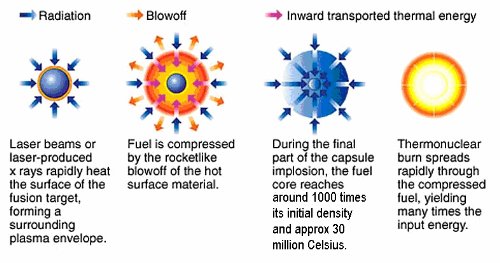For nuclear fusion to occur the nuclei that make up the fuel (Deuterium and Tritium) must be thrown together vigorously. This is the same as saying that the fuel must be hot. When a gas is hot, the individual particles that make up the gas fly about more rapidly – and so collide more vigorously. The temperatures required for fusion are such that the gas we are dealing with is no longer composed of neutral atoms, but of charged ions and electrons. Such a gas is called a plasma– sometimes called the ‘Fourth State of Matter.’
The reason why the particles must collide vigorously in order to fuse is that nuclei have positive charges. Like charges (e.g. two positive charges) repel one another due to the Electromagnetic Force. It is only the presence of the Strong Nuclear Force that permits the nuclei to stick together. However the attraction of the Strong Nuclear Force only operates at extremely short range. Throwing the nuclei together vigorously allows the nuclei to get close enough together that the Strong Nuclear Force can make them stick.
Another factor that affects fusion is the density of the material. This can be understood by considering that whilst the temperature determines how vigorously the particles collide, the density plays an important role in determining how often the particles collide. The higher the density of the fuel, therefore, the more rapidly fusion reactions will take place, and the more energy will be released in a given period of time.
In ICF, conditions of extremely high temperature and density are achieved by imploding a spherical capsule containing fusion fuel. This implosion is driven by laser radiation or soft x-rays. An implosion is basically the reverse of an explosion. In ICF we start off with a spherical shell that is a couple of millimetres in diameter, and make it implode upon itself until it is only a hundred microns or so across. The mechanism by which this is achieved is rather like the process that propels rockets into space. The outside of the capsule is made to expand rapidly outwards – much like a rocket exhaust. Then, by Newton’s third law, which states that “for each action there is an equal and opposite reaction”, the rest of the capsule implodes inwards. The expansion of the capsule surface is caused by intense heating with laser radiation or x-rays.

The fuel is compressed to densities around 1000 times the original solid density of the fuel, and its temperature is raised to around 30,000,000 Celsius. In these conditions the fuel starts to fuse, and release energy, which makes it get even hotter. In a few tens of trillionths of a second the fuel self heats to over a billion Celsius, releasing as much energy as is stored in a stick of dynamite. This energy can then be captured in the reactor vessel and converted into electricity.
ICF has not yet been demonstrated in the laboratory. The National Ignition Facility is attempting the first demonstration of this approach to energy generation. However there is a long way to go. The National Ignition Facility only aims to demonstrate the process of energy release – it will not be a power station since there will be no way to harness the energy released when the fuel is burnt. Also the laser which drives the implosion process can only be fired once every few hours. Not nearly often enough to release the quantities of energy required to make it a useful backbone for an electrical generator. That requires a laser that fires at a high repetition rate (e.g. once a second or more.) The National Ignition Facility represents only the first step along the road to power production: commercial electricity generation by ICF is not envisaged until around the middle of the 21st century!
At York, much of the work carried out relates to a particular variant of ICF known as fast ignition.
